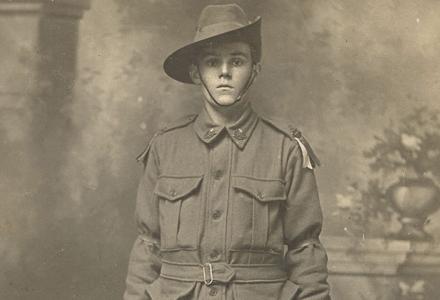Caroline Gilbert was the mother of ten children. She sent three sons to war. And not one of them returned to her.
Robert died of ‘multiple wounds’ in France. Both his legs were ‘shattered’ when a shell fell near his trenchline in Gueudecourt and he died before he even reached the ambulance. At the charge of the Light Horse at Beersheba, Charlie received gunshot wounds to the head and was killed.
Albert's death was probably the hardest to deal with. Caroline’s youngest son was ‘blown to pieces’ in Belgium. His comrades ‘gathered up different parts of him’ and buried what they could in the mud. She was told that one day, perhaps after the war, someone might find his final resting place. So she wrote one letter after another to the authorities: ‘I have waited for years hoping that I would receive the photo of my third beloved son's grave, but it has never come… The Graves committee promised to send me a photo … Dear Sir, I will be most sincerely grateful to you if you can obtain any information’.
No such information ever came. Private Gilbert’s name is carved on Menin Gate, amongst the legion of the missing.
Never able to visit her sons’ graves, Mrs Gilbert raised her own memorial: A photograph on a mantelpiece, a letter folded in a bible, the treasured ‘personal effects’ eventually shipped home to her. And on the fifth anniversary of the declaration of war, she attended the dedication of Perth’s Avenue of Honour. Two rows of Royal Oak trees were planted in the bush lands of Kings Park, all raised from seeds sent from Windsor Castle. Although she was old and partly deaf Mrs Gilbert heard something in the speeches, drowned out though they were by a downpour of rain. These ‘sons of Empire’, it was said, ‘gave their lives in the cause of justice, freedom, and right’; their names have become ‘immortal’. But Mrs Gilbert knew better than most the cost of that war. ‘I have given my three sons for the Empire’, she wrote in 1918, ‘and have no more to send’.
Caroline Gilbert’s story reminds us of the way families sought to materialise their grief, and somehow make an absent body present again. It alerts us to the role Avenues of Honour played in the process of grieving and how they served as a kind of surrogate funeral for the dead. Finally, the story highlights the multiple loss felt by thousands of family. Many mothers (and fathers) lost more than one son.
For full attribution of sources, suggestions for further reading and an extended version of the story itself see ‘No more to send: Caroline Gilbert’ in Bruce Scates, Rebecca Wheatley and Laura James, World War One: A History in 100 stories (Melbourne, Penguin/Viking, 2015) pp. 113-114; 356.



